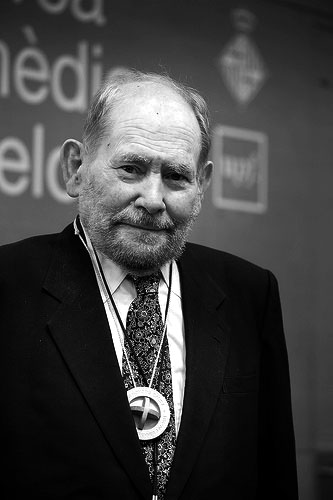Sydney Brenner, PhD, a pioneer in genetics, molecular biology and neuroscience who collaborated closely with Scripps Research scientists, died April 5 at the age of 92.
Brenner devoted his career to conducting groundbreaking basic research, making seminal discoveries about how the genetic code is expressed to produce proteins and establishing the roundworm C. elegans as a critical model organism in science, which laid the groundwork for decoding the human genome.
“Simply put, he was one of the greatest minds of the 20th Century,” says Kim Janda, PhD, the Ely R. Callaway, Jr. Professor of Chemistry at Scripps Research, who worked closely with Brenner.

Born in South Africa, Brenner studied at Oxford University and was one of the first people to see the DNA model created by James Watson, PhD, and Francis Crick, PhD. “The double helix was a revelatory experience; for me everything fell into place, and my future scientific life was decided there and then,” Brenner wrote.
He later worked closely with Crick, sharing an office with him for 20 years at the Medical Research Council Laboratory of Molecular Biology at Cambridge, UK. Crick and Brenner showed that DNA is a triplet code, where groups of three DNA letters specify each link in the amino acid chains that serve as the backbones of proteins. Brenner also co-discovered messenger RNA (mRNA), a critical intermediary in the expression of genes into proteins.
He then turned his attention to studying a tiny roundworm, Caenorhabditis elegans, better known as C. elegans, and established it as a primary model organism for studying the genome, nervous system and developmental biology. With colleagues, he made numerous advances in studying C. elegans, leading to the discovery of programmed cell death. For their achievements in this area, Brenner, H. Robert Horovitz, PhD, and John Sullivan, PhD, shared the Nobel Prize in Physiology or Medicine in 2002.
In the early 1990s, Brenner began a fellowship at Scripps Research, where he collaborated closely with Richard Lerner, PhD, then director of the institute. In 1992, they published a paper introducing the concept of DNA-encoded libraries, a technology for using DNA barcodes to organize large libraries of chemical compounds. Working with Janda, Brenner and Lerner implemented one of these DNA-indexed chemical libraries in 1993. The technique has since become a powerful and widespread research method in academia and the pharmaceutical industry.